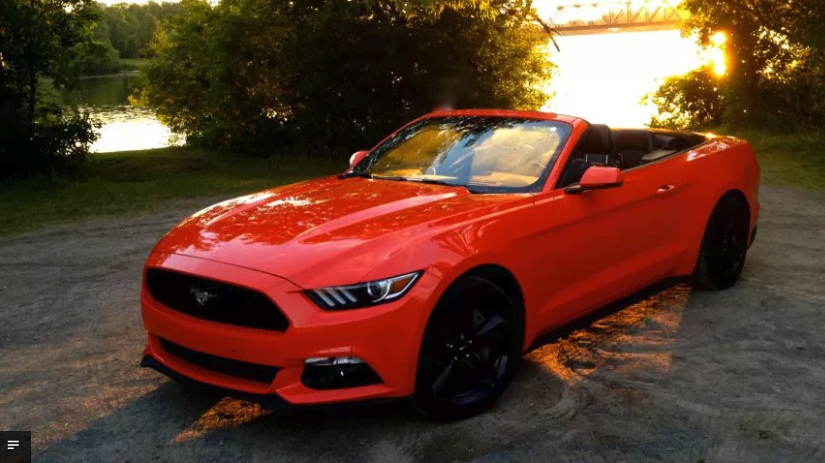Road Test: 2015 Ford Mustang Convertible EcoBoost

Story and photo by John LeBlanc
Ugh. Fall. The air turns from humid to crisp. Available daylight becomes precious. Lawn furniture is ready for storage. But one way to extend the summer is to take an open-air car for a drive, just like this new Ford Mustang Convertible.
Open-air driving and Mustangs are as compatible as pancakes and maple syrup. Fittingly, the first Mustang to roll out of the factory in March 1964 was a convertible and, except for a brief hiatus between 1974 and 1983, there’s always been a Mustang for open-air driving fans. Like the original, today’s Mustang Convertible sports two doors, 2+2 seating, rear-wheel-drive, and, along with its Fastback hardtop sibling, arrived all-new for 2015.
Just like a half-century ago, you pay extra for open-top Mustang motoring. On top of the Fastback, there’s a $4,500 across-the-board price hike for the three Convertible models, starting around $30,000 for the base 300 horsepower and 280 pound-feet of torque 3.7-litre V6 Convertible. The topline Mustang Convertible GT with its 435 hp and 400 lb.-ft. 5.0L V8 starts at just under $50,000.
Sandwiched in between the V6 and V8 models is my Mustang Convertible EcoBoost tester that started just under $40,000. The EcoBoost engine is the first four-cylinder in a Mustang since 1993. Like that four-banger from the dusty past, the current unit also displaces 2.3L. But instead of a paltry 105 hp, today’s turbocharged and direct-injected four makes 310 hp and 320 lb.-ft.
Like all Mustangs – hardtop or cloth top – the Mustang Convertible EcoBoost sports a standard six-speed manual gearbox. My ride added $8,250 worth of upgraded audio, reverse park assist, navigation and a Performance Package that included larger 19-inch tires wrapped around painted aluminum wheels and a 3:55 ratio limited-slip axle. While I drove a 2015 edition, changes for 2016 are limited to some new appearance packages and LED turn signals tucked under the lip of the hood vents on Mustang GT models (a nostalgic nod to the 1967 Mustang).
When the next-generation of the Mustang’s archrival 2016 Chevrolet Camaro convertible arrives later this year, it too will sport a turbo-four. It’s only a 2.0L, though, making a less impressive 275 hp and 295 lb.-ft. But the Chevy is promoting the new Camaro Convertible’s fully electronic convertible top that will raise or lower with the key fob or a single push of the overhead console button – even when driving up to 48 kilometres per hour – whereas the Ford requires a twist of a single windshield header handle (reduced from a pair in 2014) to unlatch its cloth top (vinyl is no longer used) first, then power it back with a button, all while stationary. Hydraulic instead of electric motors means the top goes up and down in only seven seconds, about half the time of the last version.
Once the top is down, open-air motoring in the Mustang Convertible is relaxing and enjoyable. Windows up and on the move, there’s little wind buffeting in the Ford at around-town speeds. Ride comfort levels for such a sporty car are quite good. Like the Mustang Fastback, the Convertible finally gets an independent rear suspension that handles road imperfections nicely.
Whether the Mustang’s top is up or down, it’s easy to enjoy being inside. The Ford’s front seats are both comfortable and supportive. Make sure you call “shotgun!” though – passengers relegated to the back seats will notice a distinct lack of legroom. The level of fit and finish and use of high-quality materials is noticeable, with soft-touch plastics and real aluminum and leather assembled tightly and accurately. And all of the controls have been logically laid out and are easy to use.
Beyond cruising around with the top down, my Mustang Convertible EcoBoost was also handy in the curves. The new independent rear-end helps keep the rear-drive convertible under control over bad pavement, this despite the open-air version taking on over 100 kilograms of curb weight over the Fastback. You can get a six-speed automatic transmission. But the manual gearbox makes the Ford more fun to drive: shifts are clean, direct and crisp.
One aspect of the Mustang Convertible EcoBoost’s driving demeanour that was too retro for my liking was its loosey-goosey front-end handling. Like convertibles from the past, the loss of the ‘Stang’s roof has lessened the car’s overall torsional rigidity, leaving the front-end feeling loose and resulting in cowl shake over bumps.
Keen drivers may also take issue with the Mustang’s EcoBoost turbo-four.
With a combined city and highway fuel economy estimate of 9.2 L/100 km, yes, the EcoBoost betters the Mustang’s V6 (11.2) and V8 (12.5) at the pumps. And its horsepower and torque numbers are relatively good (especially when compared to the Mustang’s last turbo-four from the early 1980s). But if you’re looking for performance or engine aural delights, you’ll go wanting. Despite being rated higher and costing $10K more, the Mustang Convertible EcoBoost’s 6.3 seconds zero to 100 km/hr time is about 0.6 seconds slower than the V6. Accelerate hard, and the sound coming from the four-cylinder Mustang’s engine bay starts with a groan and finishes with an even loud turbocharger whine.
Keep in mind: the Mustang Convertible’s best parts, its high-quality interior and slick-shifting stick, can be had with all three engines. So if you want to brag you have a four-cylinder in your Ford convertible, go right ahead. But I’d either go with the less expensive V6 or the better performing and sounding V8 for your open-air Mustang fall cruises.





![[del.icio.us]](https://www.straight-six.com/wp-content/plugins/bookmarkify/delicious.png)
![[Digg]](https://www.straight-six.com/wp-content/plugins/bookmarkify/digg.png)
![[Facebook]](https://www.straight-six.com/wp-content/plugins/bookmarkify/facebook.png)
![[Google]](https://www.straight-six.com/wp-content/plugins/bookmarkify/google.png)
![[Reddit]](https://www.straight-six.com/wp-content/plugins/bookmarkify/reddit.png)
![[StumbleUpon]](https://www.straight-six.com/wp-content/plugins/bookmarkify/stumbleupon.png)
![[Twitter]](https://www.straight-six.com/wp-content/plugins/bookmarkify/twitter.png)
![[Email]](https://www.straight-six.com/wp-content/plugins/bookmarkify/email.png)